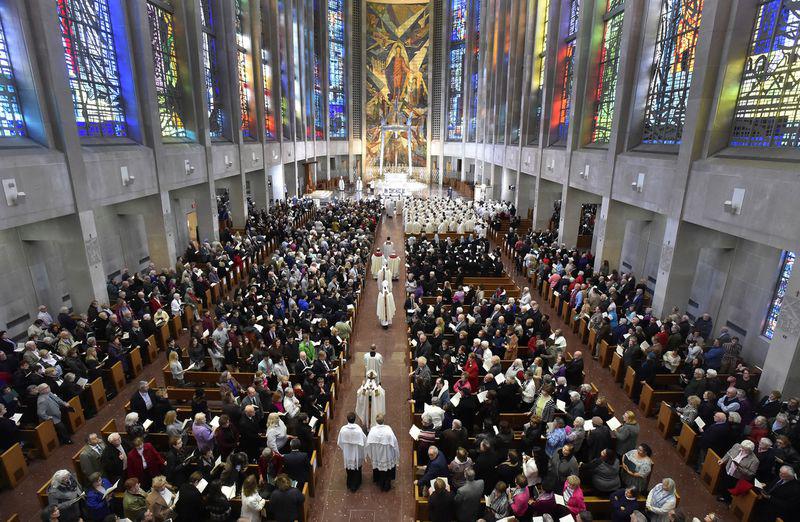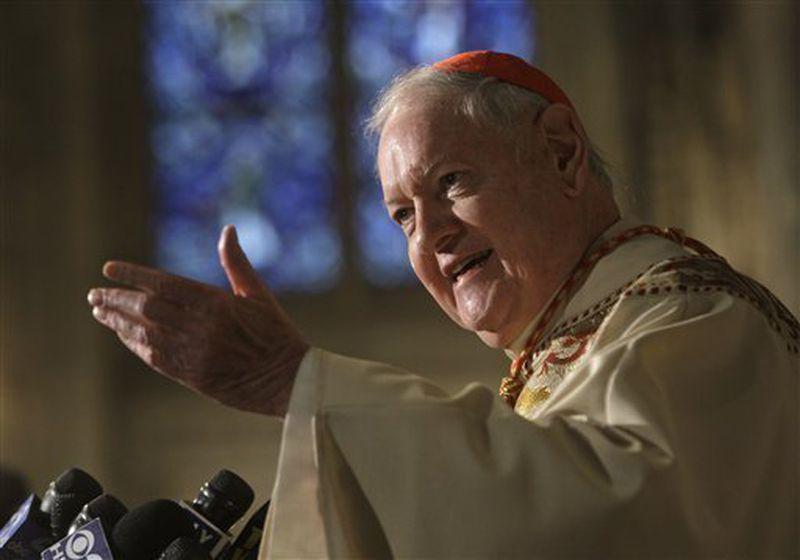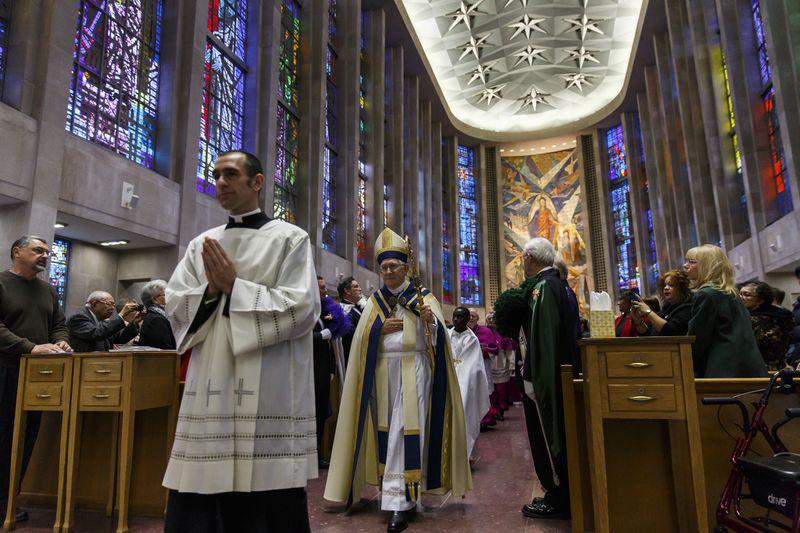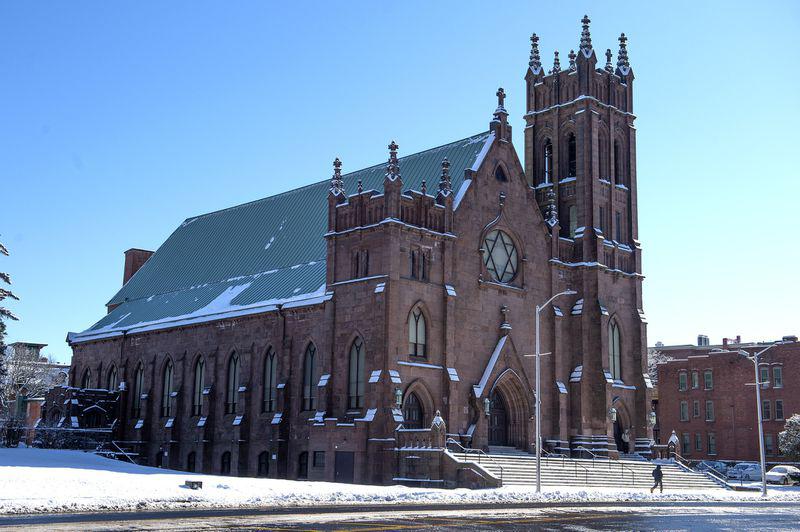|
Stories that shaped the decade: Catholic Church struggles with new revelations about priest abuse scandals and declining attendance
By Dave Altimari
Facing a declining number of Catholics attending Mass, the Catholic Church closed churches and struggled with new revelations about abusive priests during the past decade. In 2016, the church announced plans to close or consolidate dozens of parishes, citing fewer registered Catholic households and a shortage of priests. Since 1965, the Hartford Archdiocese reported, there has been a 69% decline in church attendance. Meanwhile, a grand jury investigation in Pennsylvania in 2018 that led to hundreds of priests being accused of abuse rekindled the sexual abuse scandal that rocked the Catholic Church in Connecticut and around the country more than a decade ago. Looking back over the past decade, Courant editors and reporters have selected Connecticut’s top news stories. The continuing challenges facing the Catholic Church were among the stories that shaped the decade. After the Pennsylvania investigation — which named at least 300 priests and more than 1,000 victims — all three dioceses in Connecticut opened secret files to reveal more priest sexual abuse cases. In Hartford, Archbishop Leonard Blair said in early 2019 that it was time to address the “dark cloud” that still hangs over the Catholic Church because of the priest abuse scandal. “The lingering, unhealed wounds from past abuse continue to cry out for further actions and answers," he said.
A scathing report in Bridgeport
In October 2019, the Diocese of Bridgeport announced they had 29 credibly accused priests and had paid out $52.5 million. But Bishop Frank Caggiano also hired former judge Robert Holzberg to review more than 250,000 pages of the diocese’s secret files. Holzberg released a scathing report that was particularly harsh on former Bishop Edward Egan, who went on to become archbishop of New York. The report concluded Egan was “profoundly unsympathetic, inadequate and openly inflammatory,” and whose primary responsibility was “preserving the assets and reputation of the diocese” rather than the well-being of sexual abuse survivors. The report found that 281 victims were allegedly abused by 71 priests, or about 5% of the total number of priests that have served in the diocese. “The priests who committed these ghastly acts engaged in criminal acts,” Holzberg said at a Bridgeport press conference. A total of 10 priests, including Laurence Brett, Raymond Pcolka and Martin Federici, accounted for 61% of the abuse cases. The Archdiocese of Hartford, the state’s largest diocese, released its numbers in early 2019, reporting that there 48 priests credibly accused of sexual abuse and that the diocese had paid out $50.6 million to settle lawsuits. Of the 142 claims that were settled, about 84% involved allegations against nine priests. Only one case went to trial and the diocese had to pay $1.6 million. One priest had 20 credible abuse claims against him that were settled for $10.7 million. The diocese didn’t name that priest in their report, but The Courant was able to determine it was the Rev. Daniel McSheffrey. McSheffrey, who once had a “day” in his honor in his hometown of Hartford, was a principal at a Catholic school and later assigned to a parish in Guilford. Many of the sexual assaults took place at a cottage he owned in Old Saybrook, which he called “Heaven.” “He was probably the most cunning, deceitful, sickest, sociopathic monster ever to wear a Roman Catholic collar in Connecticut,” New Haven attorney Thomas McNamara said of McSheffrey. McNamara represented several of McSheffrey’s victims. The last diocese to release their sexual abuse numbers was Norwich, the state’s smallest diocese, which had 43 priests credibly accused of sexual abuse but only had nine legal claims that it settled for $7.7 million, according to Bishop Michael Cote. Cote announced the findings in a letter that was read to parishioners at all Masses one weekend in February 2019. “I know that the release of these names will cause pain for some victims, families of the accused, friends and parishioners," Cote wrote. “It is my hope and prayer that this effort to let the light shine on this dark chapter in the life of the Church will bring some measure of peace, healing, and acknowledgement to those who have been directly harmed and to all members of our faith community.” But a prominent New London law firm that has filed many of the lawsuits against the diocese questioned Cote’s numbers, saying that their firm alone had settled sexual abuse cases worth more than $8 million. Unlike Bridgeport and Hartford, which announced they were hiring former judges to do independent reviews of church files, Cote hasn’t hired anyone to review the Norwich files.
Declining attendance, fewer churches
After years of declining attendance, the church was forced to act in 2017, when the Hartford Archdiocese announced a plan to consolidate 212 parishes into 127, including the closure of 26 church buildings. The Diocese of Norwich also announced plans to merge eight parishes into four under a new pastoral restructuring. “Neither I, as your archbishop, nor all of us together, can responsibly kick the can down the road,” Archbishop Leonard P. Blair said. “Nor can anyone retreat into their own interest alone without taking to heart the common good of the entire Catholic people of the entire archdiocese.” The Rev. James Shanley, who led the planning process in the Hartford Archdiocese, said the streamlining should have begun years ago. “We’re probably behind,” he acknowledged. In addition to fewer practicing Catholics and a graying population, the Hartford Archdiocese grappled with a shortage of priests and the financial pressures that come with maintaining aging buildings. “There are layers and layers to this change,” said Andrew Walsh, associate director of the Leonard E. Greenberg Center for the Study of Religion in Public Life at Trinity College in Hartford. “In certain respects, the landscape has been changing since the 1970s and what’s happening now is a culmination of that.”
|
.
Any original material on these pages is copyright © BishopAccountability.org 2004. Reproduce freely with attribution.



